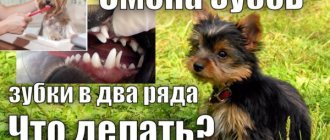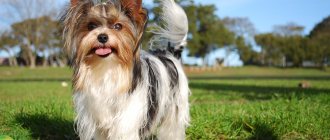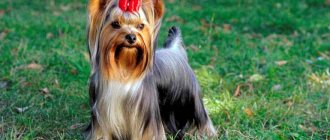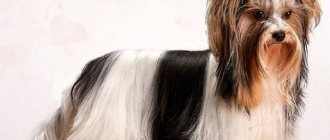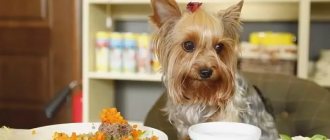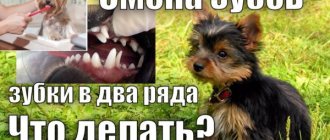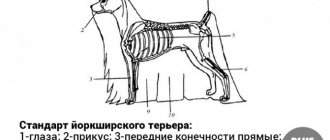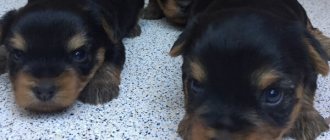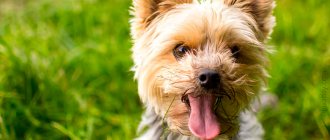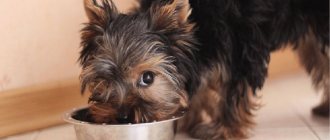Yorkshire Terriers are the most popular toy dog breeds. at first glance, their aristocracy, grace and playful manners are noticeable. It’s hard to believe, but Yorkies were once used in factories and mines to catch rats and mice, but now they live side by side with owners who never cease to admire their intelligence, cheerfulness and cheerful character.
Description of appearance
The Yorkshire Terrier is a long-haired dog with a compact and graceful build and a strong, proportional body.
Head
The head, compared to the body, is small, flat, without convex parts. The transition from the forehead to the muzzle is pronounced, dividing the craniofacial part in half.
Muzzle and jaw
The muzzle is short. The nose is small in size, nostrils are round in shape, and the nose is black. The jaws are straight, without disturbing the row of teeth. The chewing muscles are not expressed, the lips fit tightly. The teeth are small, set vertically, and no gap is formed when the jaws close. Scissor bite.
Eyes
The eyes are medium in size, round in shape, not protruding, set straight, the distance and width between them are average. The iris is of the darkest brownish hue, the eyelids are edged with black. The look is meaningful, smart and playful.
Ears
The ears are small, erect, in the shape of a regular triangle, not widely spaced. The ear cartilage is elastic, not thick. The outer part of the ears is covered with short hair of a rich shade.
Neck
The neck is of moderate length, slightly arched, with well-developed muscles, set high. The contour of the scruff is clearly defined.
Frame
The body is of moderate length, compactly folded, and has a square format. The withers are weak, the shoulders are strong, the chest is oval. The back is short and strong, the back line is straight. The abdomen is tucked up and forms a straight line. The croup is rounded and slopes towards the base of the tail. The tail is set high at the base, carried slightly above the level of the back, and covered with darker hair. It can be half docked or have a natural length, in which case it should be as straight as possible.
Limbs
The front and hind legs are strong, smooth, and the joints are well developed. The knee and hock joints are located at right angles, and the muscles on the forearms are well developed. The hands are collected, round in shape, the claws are black, convex, slightly curved.
Yorkie sizes
The breed standard adopted by the RKF and FCI limits only the maximum weight of Yorkshire terriers - it should not exceed 3 kg 100 grams, the minimum weight is not standardized. The height of Yorkies at the withers is also not specified in the standard, but it should not be more than 25 cm. As a rule, a standard Yorkshire terrier has the following dimensions: a male grows up to 23 cm and weighs up to 3.1 kg, a female weighs up to 2.7 kg and height at the withers up to 20 cm. Below you can see a small selection of photos.
Despite the absence of some restrictions, at the exhibition preference will be given to a dog whose weight is not less than 2 and not more than 3 kg.
When we choose a puppy
To choose the right one, you should know that puppies are born darker in color, and subsequently they change coat color. All puppies at the age of 2 months have black hair at the base and lighter at the tip. They all give the impression of being strong, because they have not yet stretched out or grown up. To understand what shade a dog will be, you need to study the parents and the entire pedigree. Because even standard dog breeds can give birth to mini puppies, anything can happen.
Also pay attention to the appearance of a standard puppy, if he is cheerful, and his eyes are shiny enough, there is no bad smell from his mouth, and the kennel is kept clean, most likely the puppy is already yours. Before purchasing, don’t forget to touch the belly and play with it a little; if the Yorkie makes contact without problems, everything is fine.
The following are also considered deficiencies and deviations:
- Undershot or overshot, jaw curvature;
- A curved, indirect body or in the form of an overly elongated rectangle;
- Short or long muzzle;
- Ears close or wide apart;
- Hind limbs in the shape of the letter X or O;
- The tail is carried at or below the level of the back;
- Uneven color (splashes of dark or ashy hair on a reddish head, for example);
- Cryptorchidism.
Also check whether the dog hears, breathes, and sees you well; if in doubt, come to the kennel again. But you must make the right choice, and even if your dog does not attend exhibitions, we believe that he will become your best friend forever.
Wool
For the Yorkshire Terrier, the quality of the coat, its structure and length are very important. The coat on the body should be smooth, long, completely straight, without waves, curls or hints of fluffiness. The fur on the back should be parted down the middle and flow down the sides of the Yorkie. The coat can be trimmed to ground level, thereby making it easier for the Yorkshire Terrier to move and giving it a neat and well-groomed appearance.
The hair on the head should also be long, it must be collected in a tail in the middle or in 2 tails on the sides. The ears need to be trimmed short, and the hair on the paws can also be trimmed - this gives the Yorkie a more well-groomed appearance. If we talk about the fur of the Yorkshire Terrier outside the breed standard, it is worth highlighting the following important facts:
- The structure of the coat is similar to the structure of human hair. The wool does not cause allergies, hardly falls out and grows quickly - about 15 mm per month.
- In order not to damage your pet's fur during combing, you need to choose the right comb: natural bristles are suitable for regular procedures, but a metal comb is needed to comb out tangles.
Using a slicker comb can damage your Yorkie's skin.
Yorkie weight table by month
| Age by month | Weight |
| 0-1 | 200-400 gr |
| 1-2 | 400-700 gr |
| 3-4 | 700-1100 gr |
| 5-6 | 1100-1500 gr |
| 12 | 2000-2300 gr |
| 18 | 2800-3100 gr |
Color
From the back of the head to the base of the tail, the coat should have a gray-steel, but not silver, tint. Insertion of red, bronze or dark colored hair is not acceptable. The chest and paws from the ground to the elbows and knees are covered with bright and rich golden-brown fur with darker roots.
The coat on the head also has a golden-brown tint, more saturated on the sides, near the ears and in the muzzle area. The ears are reddish-yellow-brown in color. This color should not extend to the neck and mix with the main one.
Yorkshire Terrier puppies are born with a black coat color and small spots of red tan; it is impossible to predict the color of an adult dog.
Main settings
The RKF (Russian Cynological Federation) in its standard uses the same standards for Yorkshire Terrier dogs as in the standard adopted by the FCI (Federation Cynological International).
The FCI standard approved for the Yorkshire Terrier dog breed is general parameters taken from the standards of those countries where breeding representatives of this breed are bred.
Basic norms of the RKF standard:
- general form;
- temperament;
- movements;
- head;
- frame;
- limbs;
- wool cover;
- color;
- defects and defects;
- dimensions: weight and height.
Character
Yorkshire Terriers are very active and energetic dogs that have difficulty sitting in one place. They quickly become attached to their owner, are devoted to him and are always ready to defend him. They treat strangers well and kindly, but not from the first minutes - they need time to adapt. They feel great in a pack, are friends with other dogs and even cats, love children and get along easily with them.
The peculiarity of the nervous system is rapid excitation and a rather long process of calming down. They have a choleric temperament and are not characterized by fearfulness and aggressive behavior. Despite the fact that now Yorkies are decorative dogs, the blood of their ancestors remains in them and even the smallest representatives of the breed are capable of hunting.
Among the positive qualities of the Yorkshire Terrier are:
- Equilibrium.
- Friendliness.
- Attentiveness.
- Playful character.
Negative qualities:
- They do not tolerate loneliness well.
- They need a special approach to education.
Yorkshire terriers have a high level of intelligence, the breed is included in the TOP - 50 smartest animals.
Interesting Facts
- The origin of the breed is not known with certainty. Here are some possible parents: Clydesdale Terrier, Dandie Dinmont Terrier, Leeds Terrier, Maltese Terrier, Manchester Terrier, Paisley Terrier, Skye Terrier, Waterside Terrier.
- The word "terrier" refers to a small and feisty dog that was once used to work underground and hunt in small, inaccessible places.
- There are many famous Yorkie owners. For example, Audrey Hepburn, Joan Rivers, Missy Elliott, Natalie Portman, Paris Hilton and Simon Cowell.
- York, named Famous, played in the movie Funny Face with Audrey Hepburn.
- A York named Pasha, owned by First Lady Tricia Nixon, once lived in the White House.
- Huddersfield Ben is the most famous Yorkshire Terrier. The dog was named after the city in which he was born. This dog belonged to a man named M. A. Foster. Huddersfield Ben has become very famous after winning over 70 shows and countless competitions.
- Thanks to the long hair, you can come up with various beautiful hairstyles for your pets. For an uncut pet, you can tie the hair in a ponytail or braid it.
Predisposition to disease
The average life expectancy of Yorkshire terriers is 12 - 15 years, however, how long a Yorkie will actually live depends on the conditions of its maintenance, provision of proper care and the health of the pet. Yorkies have a short muzzle, which leads to frequent eye injuries and fontanel failure, which means the risk of fatal head injuries increases.
Eye diseases also include conjunctivitis , which develops due to a narrow tear duct and hair constantly getting into the eyes, and distichiasis, a disease in which an additional row of eyelashes grows, as a result of which the eyelashes bend, grow inward and injure the cornea.
To prevent the fur from getting into the eyes, it must be combed daily and collected in a tail.
Another weak point of the Yorkshire Terrier is its teeth. In representatives of the breed, the replacement of teeth may be disrupted, when permanent teeth begin to grow on top of the milk ones that have not yet fallen out. In such a situation, it is necessary to remove the baby teeth under anesthesia in a veterinary clinic. Untimely and irregular brushing of teeth leads to the formation of plaque, tartar and, as a result, periodontal disease, leading to tooth loss.
Lack of oral care for your pet can lead to tooth loss as early as two years of age.
If we talk about diseases of the musculoskeletal system, then often in Yorkshire terriers Perthes' disease occurs, in which the head of the femur is destroyed. The disease begins to manifest itself in a three-month-old puppy and leads to lameness.
Breed diseases of Yorkies also include:
- Allergy.
- Skin diseases.
- Hypoglycemia.
- Sensitivity to drugs.
- Dislocation of the kneecap.
- Pancreatitis.
- Underdevelopment of joint ligaments.
- Inguinal hernia.
- Hydrocephalus of the brain.
Most diseases occur as a result of improper care of your Yorkie.
Defects and defects
Defects are any deviations of a dog from the accepted breed standard; they are of 2 types: shortcomings and defects. Faults are minor deviations from the standard that do not affect the general condition of the dog and do not lead to disqualification. This type of defect includes:
- Poorly developed muscles.
- Rounded skull.
- Light pigmentation of the iris.
- The absence of several teeth or the presence of plaque on them.
- Color mixed with other shades.
Defects are serious violations of the standard that raise doubts about the purebredness of a given representative of the breed. These include:
- Curly coat.
- A color pattern that completely or partially does not correspond to the standard one.
- Ears rounded at the ends.
- Blue eyes or heterochromia.
- A hump or sagging line on the back.
- Defect in the position of the front and hind legs when walking.
There are also more serious defects - defects that lead to immediate disqualification of the dog:
- Color that does not correspond to the breed standard.
- Dog weight exceeding 3 kg 100 grams.
- Drop or semi-drop ears.
- Too aggressive or, conversely, timid behavior of the animal.
- Non-scissor bite and missing row of teeth.
- Cryptorchidism is the failure of one or two testes to descend into the scrotum.
Frame
The compactly built body of the Yorkshire Terrier has slightly rounded ribs, which makes the chest appear oval. The straight line of the back should be short and well developed.
The animal's tail is almost always docked - in dogs of this breed, half of the entire length is usually removed.
In the UK, Yorkshire terriers with uncut tails have recently been allowed to participate in exhibitions. But the FCI standard has not yet made changes in this regard. Therefore, the position and length of the animal's intact tail are still unknown.
Male Yorkshire Terriers should have well-developed testes that are completely contained in the scrotum.
Differences from mini
If a real terrier lives in the body of a standard Yorkshire terrier, then mini Yorkies (weight 1.5 - 2 kg) have a softer character. The difference also lies in the fact that smaller ones have a less thick and long coat, which is easier to care for than the coat of a larger standard Yorkie.
Mini Yorkies are easily injured even on their own, and even more so it is impossible to avoid injuries in families with small children, who, through negligence, can cause significant harm to the health of a tiny dog. Also, unlike the standard representative of the breed, Mini Yorkies are not suitable for breeding.
History of the origin of the breed
The breed originated in England. It inherited its name from the county of Yorkshire of the same name. It is believed that her ancestors were Waterside Terriers, which were widespread in this county due to their small size.
At that time, the size of the Yorkie standard should not have exceeded 18 centimeters. Peasants were prohibited from keeping dogs larger than a certain size. The big dog was a privilege of the rich. This was done to protect the lands of the nobility from encroachment on the game that the lands of their owners were rich in, from those who did not have the right to hunt there and poached.
It was difficult for the peasants to survive without these babies. They were excellent rat catchers, protected crops and barns from rodent infestations, guarded households, and helped in hunting small game.
According to another version, Yorkies descended from Maltese dogs. This is evidenced by their beautiful, silky, high quality coat, reminiscent of a Maltese coat. This is especially noticeable on Yorkies with light coat color.
Yorkies settled all over the globe thanks to peasants who left the county in search of work, as well as traders who traveled around the world with their four-legged friends.
For reference! The first Yorkies were entered into the British Kennel Club studbook in 1896.
After 2 years, the first community of lovers of this breed appeared. In those days, an adult standard Yorkie weighed 6-7 kilograms and had an elongated body with a blue coat marked with tan.
Yorkie family
